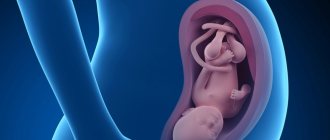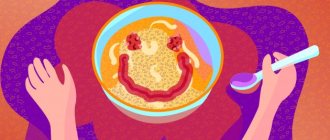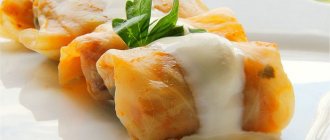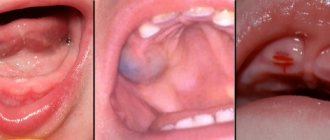Pediatrician → Patient → Teeth cutting
Ask a Question
TO THE SECTION EDITOR (reply within a few days)
July 23, 2007 10:39
All children cut their teeth in completely different ways: for some, the teething process occurs painlessly and does not in any way affect the baby’s well-being, while others, before teething, become restless, capricious, whiny, “hanging on their chest” or - if the mother does not breastfeed the baby - just in the arms of mom and dad, drool flows like a river, the gums swell, turn red, itch, itch, or, on the contrary, turn white. Children often sleep poorly and constantly wake up screaming at night. Also, when teeth are being cut, the child’s body temperature often rises and indigestion appears. It is very important to correctly assess the symptoms and not confuse them with an incipient viral infection, cold, flu, acute respiratory viral infection, etc.
Teething: how to help your baby get through a difficult period
Baby teeth usually appear in pairs with an interval of 1-2 months, and in girls this process proceeds a little faster than in boys. First, at 6-8 months, two central incisors “hatch” from the lower gum, followed by two upper incisors at 8-10, then, at 10-11, two lateral incisors emerge from below and within a month a couple more from above . By the age of one year, the child already has 6-8 bluish-white pearls in his mouth. After this, as a rule, there is a break of several months, after which 2 molars appear in a short time, first from below, then from above. And when your baby turns two years old, you will hardly be able to imagine the baby toothless - after all, he will have as many as twenty milk “bogatyrs” in his mouth!
Streams on the chin
Some children take a long time to cut their teeth - each baby can “torture” for about a week. For others, on the contrary, everything goes quickly and painlessly - at night the baby whines and tosses and turns a little, and in the morning the parents accidentally discover a tiny “new arrival” in the child’s mouth. In any case, a couple of weeks before the appearance of the first incisor, the salivary glands are activated: after all, the body is preparing to absorb solid food. The baby knows how to swallow milk and formula, but he is not yet able to cope with viscous streams, so they flow down his chin and accumulate in the folds of his neck. This causes additional anxiety for the baby: the enzymes contained in saliva irritate the baby’s delicate skin. Therefore, tie a cotton bib under your child’s chin, and when he sleeps, put a towel under his head. Carefully remove excess saliva using warm water and a blotting cloth, but under no circumstances wipe the child’s face with napkins. Gently treat the skin around the mouth with softening baby milk or natural cream, such as coconut or almond oil.
When the baby lies on his back, saliva sometimes flows into the throat, causing a reflex cough. To avoid this, turn the baby's head to the side.
Cold for gums
Just before each tooth appears, for one to two days, the child may become restless, cry frequently, and have difficulty sleeping. If you look into his mouth, you will immediately see the cause of the ailment - swelling and redness on the gums, where the incisor is about to appear. Don't be alarmed if you notice a bruise there. This is nothing more than a blood clot under the mucous membrane. It is not surprising that at this time many babies begin to eat worse. Therefore, cool applesauce, grated peaches or yogurt will be more pleasant for the baby than regular food.
There is a proven way to relieve pain: take a cotton napkin, soak it in chamomile tea, roll it up and put it in the refrigerator. The next time your child starts whining, let him chew this “compress” a little, and the baby will feel better.
small rodent
A teething child gnaws on everything he can get his hands on, thus “scratching” his itchy gums. It’s good if the role of the “massager” is played by a finger, pacifier, cup or spoon, but sometimes the mother’s breast comes under attack during feeding. So be on your guard: if suddenly the baby does bite you, do not scream or spank the innocent child. He doesn't know that you're in pain. Just press your thumb on your baby's chin and he will open his mouth.
To fully satisfy the desire to chew, be sure to buy your child small rubber or plastic toys that have passed safety control, which he will happily bite. But it is strictly not recommended to irritate the baby’s gums by scratching them with a piece of sugar or the handle of a spoon, as was done before. This can damage delicate baby teeth and cause infection. Be careful with bagels, bread crusts, bagels: crumbs can get stuck in the respiratory tract.
Often, to calm a child irritated by itching, parents give him a pacifier lubricated with honey. The remedy, needless to say, is quite effective. The sweet taste really distracts the baby from the unpleasant sensations in the gums. Try, however, not to resort to such techniques, otherwise caries in the future is guaranteed.
When a child begins to cut his first teeth, the “mother’s dairy factory” closes in 75% of cases. If you are not ready to stop feeding because of this, buy special pads for your breasts that will absorb the pressure of the little toothy.
Run to the pharmacy
When the first teeth are cut, children often develop a fever - this is normal. But if it rises above 38.3° C, he refuses more than two feedings in a row or is malnourished for several days, consult a doctor immediately. It is possible that the baby has a bacterial or viral infection. Paracetamol-based products will help bring down the fever, but under no circumstances aspirin. And special candles that need to be inserted into the butt will cope with the pain.
Please note that when using any medications, you should consult your doctor. Sometimes the pediatrician prescribes small doses of painkillers.
Expert opinion
Tatyana Vaselenyuk, dental surgeon: Some primary incisors grow straight, others grow obliquely. This is not a cause for alarm; they will gradually straighten out. A sparse dentition should also not cause concern for the mother: it is not at all necessary that this will affect the permanent teeth. But if teething is irregular, with long breaks and not in pairs, you should be wary and show the child to a pediatrician and dentist as early as possible. This may indicate rickets, a disease that occurs due to a lack of vitamin D in the body, or other problems with the baby’s health.
Dental tricks
Children's toothpaste has a pleasant taste (apple, banana, raspberry, strawberry), gently cleanses children's teeth without damaging the enamel, and protects them from caries and tartar. Paste for crumbs, if it does not contain toxins, antiseptics, fluoride and dyes, does not need to be spat out or washed off during cleaning. She is absolutely harmless. How much product is needed for one cleaning depends on the number of teeth. This is usually a pea-sized ball.
Silicone massager brush
It is a transparent cap, at the end of which there are many short silicone hairs or pimples. The peculiarity of the brush is that, like a thimble, it fits on the index finger or little finger. With its help, you can not only gently remove plaque from your first teeth, but also massage your gums. Children usually really like this procedure.
Toothbrush for little ones
should have super soft bristles that gently clean baby teeth. In addition, on the product you choose, you need to find an indication for what age it is intended (for example, 0-2, i.e. from the moment the first tooth appears to 2 years, etc.). The head with bristles should be small and compact (the size of two baby teeth), and the handle, on the contrary, should be large and voluminous, with rounded safe edges to make it easier and more convenient to hold. The first brushings will take a few seconds, but as you get used to it and the remaining teeth erupt, the time for hygiene should be increased. It is necessary to change the brush at least once every 2 months, and also if the child has had a cold or infectious disease.
Cooling rings
are made in the form of figures: ice cream, cherries, fruits, vegetables, etc. These devices have an analgesic effect, stimulate and cool the child’s gums in the initial phase of teething. Before letting your baby chew on a ring filled with gel, you need to put it in the refrigerator for 2-3 minutes.
www.aif.ru
Teething in children: symptoms and signs
In the vast majority of cases, the first signs of teeth appearing in infants appear at 4-7 months. The main signal that a child’s baby teeth are beginning to erupt is excessive salivation and painful, swollen gums. You should know that teething, the symptoms of which appear long before the main moment - the appearance of the first tooth, begins to appear in about 1-2 months. Painful sensations in the gums cause many unpleasant moments for the child. When teething (see photo), in most cases the gums are smoothed this way. At this time, the baby does not sleep well, is constantly capricious, and there is practically no interest in food. Parents should take all these signs of the appearance of the first tooth calmly. Any anxiety and nervous state of the mother is instantly transmitted to the child. Other signs of a baby’s “growing up” include:
- temperature increase;
- moist cough;
- runny nose;
- diarrhea.
It is not at all a fact that all of the above conditions for the appearance of the first tooth should be experienced by your baby. Depending on the physiological characteristics, everything is very individual. We will consider all possible painful conditions of the child when cutting his first teeth and give appropriate recommendations.
How to calm your baby when teething
Is your baby already 6 months old? Are you waiting for the sleepless nights to begin due to cutting your first teeth? Or has this moment already arrived, and you don’t know how to help your child? Let's look at the basic tips and recommendations that will help calm the baby and alleviate such unpleasant sensations.
Tip 1
Check to see if your child's discomfort is related to the eruption of his first teeth.
Fever, whims, crying and other unpleasant situations should not at all be associated with malaise when teeth are being cut. Examine the child, perhaps he just wants to eat or peed, and colic cannot be ruled out.
Tip 2
In case of severe pain, give your child a bath.
Warm water is a great way to distract and calm your baby. Run a bath and play with your baby. After the bath, give a light massage using baby oil. This procedure will not relieve pain when teeth are being cut, but it will definitely distract the baby for a while.
Tip 3
Replace your nipple with a cold water bottle
If, while breastfeeding, your baby begins to chew on your nipples and thereby drown out the pain in his mouth, cheat. Pour very cold water into a bottle and give it to your baby. The baby will gnaw on the tip of the pacifier with great pleasure, the cold temperature of which will gradually relieve the pain. This is a great way when a baby is teething, and mothers will no longer experience itching from cracked nipple skin.
Tip 4
The cold is at the head of everything!
Remember how ice applied to the area of pain helps a lot with bruises? So this same principle can be used when calming a child when his first baby teeth are cutting. Don't forget to put your teethers in the refrigerator. The cold will soothe the poor baby's gums and relieve the aching pain almost instantly. Before doing this, be sure to read the instructions for the teether.
Tip 5
Use a regular cold cloth
A quick and at the same time economical option for all mothers is an ordinary clean cloth or handkerchief. The cloth should be wetted and then cooled in the refrigerator. Next, gently apply the cold cloth to your baby's cheeks. Cold will relieve pain and soothe a crying child. Just remember to use a completely hygienic cloth so as not to cause irritation.
Tip 6
Use a nibbler
Nibbler is a new product on the baby feeding market. This is an excellent and convenient tool not only for helping a little person begin to try solid food after complementary feeding, but also for massaging the gums. When the first baby teeth are coming in, put something tasty in the nibbler and your baby will get busy in no time. You can use a banana or other fruit, as long as it is cold and soft. Your child will be happy. After use, do not forget about the rules of mandatory hygiene and wash every part of the nibbler, especially the mesh.
Tip 7
Use your own finger
A mother's clean finger can calm anyone. Gently rub your child's aching gums and you will notice how he calms down. You need to apply light pressure on the gums with your finger for several minutes. After this, sit comfortably with your baby and let him chew your finger. Be prepared for the fact that you can be bitten even without teeth. Such simple methods of calming a baby when he is teething are available to all mothers and do not cost anything. Well, it might be worth your troubles.
Tip 8
Use your own chin
Just like the previous method, this advice will be useful to any mother when there is no water available to wash her finger or you have forgotten a special teether. Wipe the chin with a clean cloth or water and let your baby chew on it. This method of relieving gum pain when a child is teething may seem a little strange to you, but it really works.
Tip 9
If a child has a fever, use an antipyretic
When the first baby teeth are cut, there is often an increase in temperature. In this case, use Nurofen or Ibuprofen. They will quickly relieve the temperature, which in turn will also slightly soothe the baby’s aching gums.
We advise you to try each method until you find the most effective one. If even after trying all the methods to calm the child, nothing helps, you should see a doctor. Perhaps the situation is much more serious, and only a specialist can prescribe the best solution. In any case, when teeth are cut, it is unpleasant both for the baby and for his parents.
Therefore, let's look at some more recommendations that you should arm yourself with during this period of your baby's life:
- When the first teeth are cut, the child often wakes up at night. These days you need to be ready to breastfeed or bottle feed your baby. In the future, do not worry, the child will independently wean himself from the habit of eating at night.
- Keep teethers in the refrigerator, but when you give them to your baby, make sure they are not too cold. Still, we are talking about tender gums.
- When teething, your baby may experience excessive salivation, a runny nose, or skin irritation. This is normal and considered a side effect. Just see your doctor.
- When choosing a product or a special toy that your baby will happily chew on, do not choose one that is too small. Firstly, the small size can play a cruel joke and cause suffocation, and secondly, a large object is more convenient to hold.
- Don't forget that your baby will also happily chew on the handle of the trolley in the supermarket. Be sure to buy a small hygiene case and take it with you every time you go to the store with your baby. So, you will protect the child from a number of contagious diseases, and also soothe the child’s gums when teeth are being cut.
- Use homeopathic remedies, they are safe.
- Beware of using various gels and products to reduce pain when teething. If used improperly, they can get into the baby's throat and cause irritation.
The first teeth, as well as the first steps of a son or daughter, are a very important event for the whole family. And if in the case of steps, the child gets off with slight bruises, then when teething, the baby experiences real pain. We hope that our tips and recommendations will help during this difficult time. Don't be afraid or expect something terrible. Use our tips and continue to enjoy happy moments with your baby.
Every mother tries to give her baby the best. This applies to everything, but primarily to nutrition. After all, the health and immunity of a child is […]
Have you noticed that your child is constantly lying? Teach him to tell the truth, but it doesn't help? Do you want to figure out why a child lies and how [...]
Children are the greatest happiness in every person’s life. Every woman eagerly and with bated breath awaits the birth of her baby, [...]
Before talking about how to deal with whims and hysterics, I want to remind you the main thing: a child has the right to cry when he is sad, when […]
velw.ru
Causes of diarrhea during teething
A born child, while still in the womb, receives a sufficient portion of maternal immune protection, which accompanies it for the next 4-6 months after birth and provides the baby with complete immunity from various infectious diseases. The end of this protection coincides with the beginning of the formation and eruption of teeth and makes the child’s body vulnerable to various bacteria and infections. Diarrhea during teething can appear for a single reason, which has nothing to do with the natural physiological formation of an infant. Abundant blood flow into the gums is a preparation for future teething. The baby, trying to alleviate his suffering, tries to taste all the objects around him, and thereby, by irritating the nerve receptors on the gums, alleviates his condition. After this, naturally, you should expect any reaction from the body, including various intestinal infections that cause diarrhea in your child. To avoid this situation, special teethers have been invented for teething gums, which can be purchased at any pharmacy. It's safe, modern and necessary.
Read also: Tooth seven
How to calm a child when teething?
One of the physiological features of a newborn is the appearance of baby teeth. Some children experience this period calmly, while others are capricious for weeks and do not allow their parents to sleep at night. Experienced adults already know how to calm a child when teething, but young mothers and fathers are sometimes shocked by this situation.
How do teeth grow?
The formation of teeth in the gums begins in the baby during intrauterine development - the so-called base is laid. The time of teething manifests itself differently in each child - it all depends on heredity. A period of 6-7 months is considered the norm, but this is not a dogma.
At the same time, babies begin to experience anxiety as early as 3-3.5 months, since the formation of dental tissue is accompanied by severe itching. During this period, babies begin to put objects in their mouths that can be used to scratch their gums. So you shouldn’t take them away from your baby if they don’t pose a health threat.
The ability to asymptomatically endure the process of dental development in some children is genetic. Although in most cases this action is accompanied by a change in the behavior of the newborn - he is capricious, eats poorly and often cries (especially at night).
Mom is the “ambulance” who should calm the child when he is teething.
How to calm your baby during teething?
Noticing the baby's anxiety and refusal to eat, the mother examines his gums to diagnose the process of teething. Usually the soft tissue appears inflamed and swollen. At the same time, the production of saliva increases, which practically flows from the mouth, sometimes causing irritation of the skin on the chin.
The mother will be able to feel the bumps in the gums with her breasts while feeding the baby. In this case, the baby will try to scratch his inflamed gums against it. The mother's task is to calm the baby during teething.
Massage gums during teething
You can reduce itching by massaging the gums - do this with a clean finger wrapped in a sterile gauze napkin. The baby likes such actions, since massaging movements not only relieve itching, but also reduce pain.
The eruption of molars is especially painful, and this may be accompanied by high fever. At such moments, the child’s body’s immunity decreases somewhat, and the process of teeth growth is sometimes accompanied by loose stools, which frightens young mothers even more.
As soon as the pain syndrome decreases and the temperature drops, the diarrhea will stop on its own. Therefore, the main focus is on the question of how to calm the baby during teething.
How to soothe a toothache in a child?
If toothache is accompanied by fever, it is recommended to give the baby a painkiller, for example, Paracetamol in syrup. Homeopathic remedies also have a good effect, of which the Viburkol anal suppositories are often recommended.
Special teethers filled with gel and cooled (not in the freezer) provide excellent pain relief. The cold brings relief to the baby for a while, so you should always have another gel ring in reserve in the refrigerator to replace it with the one that has warmed up in the baby’s hands.
The pharmacy has a large selection of gels designed to soothe gums in young children. Some of them contain an anesthetic (lidocaine), others do not, but all have a good property of soothing sore gums.
Gels for teething. Antiseptic, anti-inflammatory drugs in the form of gels are designed to relieve pain symptoms in babies that arise during teething. These include homeopathic preparations based on plant extracts, as well as special antiseptics and anesthetics that relieve pain for a long time.
It is necessary to select a soothing gel for a child’s gums on the advice of a pediatrician, taking into account the individual characteristics of the baby. Among the frequently recommended drugs, the following are popular: “Kalgel”, “Dentinox”, “Kamistad”, “Dentol baby”, “Cholisal”.
The hardest thing for parents is when their baby becomes restless at night. Almost all children calm down when they are picked up, but this is often not recommended so that the baby does not become a habit. The same applies to feeding - if in a normal state the baby does not suckle at night, then you should not break the tradition.
At night, you can give a little milk to your newborn from a bottle or spoon. To prevent the baby from waking up several times a night from severe pain, it is recommended to use analgesic syrup, anesthetic gels or homeopathic suppositories.
When teeth are being cut, all means of relief are used in advance. It takes time to soothe the gums.
To make it easier for the baby to cope with teething and be calmer, the mother should always be there, showing maximum love and affection. The feeling of security, as a psychological factor, has a calming effect, dulling pain for a while.
imalishka.ru
Medicines for babies with swollen gums
Naturally, any intake of various medications should be under control. There is no need to immediately run to the pharmacy for painkillers during the first unpleasant signs of teething, since you can often do without medications. But if the baby reacts to this condition differently, that is, all the time, because of the pain, the child constantly cries and screams. In this case, special ointments and gels for children can help:
- Leader Baby;
- Kalgel;
- Kamistad;
- Dentol baby;
- Dentinox;
- Holisal.
Some of these drugs are made in the form of a solution. The components that are in these compositions are safe for the baby’s health. These may include antiseptic and painkillers, herbal extracts, substances that relieve inflammation and swelling.
But it is always better to consult a doctor before purchasing and starting to use a certain medicine. It’s just that some drugs can cause an allergic reaction in the baby; they must be used with caution.
Ibuprofen or paracetamol are prescribed as antipyretics for children. At the same time, paracetamol is also included in a special suspension - Panadol. This drug makes it possible to reduce pain and reduce temperature. But experts do not recommend using this product for more than 3 days in a row.
How to help a baby when its first teeth are cutting?
Babies are born without teeth, and for the first months they delight their parents with a completely toothless smile. However, the rudiments are already embedded in the tissues of the jaw and gradually the child begins to acquire the teeth he will need in the future. Typically, by the age of one year a child has 8 formed dental elements, and by the age of three he has the entire deciduous row. It is worth understanding that the process of teething is not easy, and it is always accompanied by significant discomfort for the child, and it can be either mild or very pronounced. It is important for parents to understand how they can help their child get through this stage.
The content of the article:
• When do teeth start cutting? • Teething symptoms • Sequence • How to reduce baby's suffering? • Pain relievers • Video about gel to relieve itching
What time do newborns start teething?
Knowing what a difficult period the appearance of teeth in a child can be, many parents prefer to at least theoretically prepare for it, within which it is especially important to navigate when children cut their first teeth. Thus, the very first elements of the dentition begin to erupt on average at the age of 6-8 months.
The timing of eruption can vary, and within quite significant limits, and there is nothing wrong with that. Even a situation where a baby has only one tooth erupted by the age of one is a variation of the norm. It should be clearly understood that medicine is unable to influence the rate of dentition formation. This parameter fluctuates under the influence of various factors, which may include:
- heredity;
- nutrition and its saturation with useful components;
- climatic conditions (usually in hot conditions the process occurs faster);
- gender (statistics suggest that girls get teeth earlier).
So, some temporary deviations should not give parents cause for concern, since there has never been a case in medicine where a child’s teeth without pathologies did not come out at all.
How to understand that a child is teething: symptoms
It’s worth noting right away that each child’s dental situation may manifest itself differently. So, some experience practically no difficulties during this period, but for others it becomes a real test for both the child and the parents. Typical symptoms and signs of this process are:
- sleep disturbances due to constant discomfort;
- in the place where dental elements begin to emerge, the gums become inflamed and red - this is a normal tissue reaction. It is believed that the front incisors are the largest and most difficult to come out of, but some children do not feel much discomfort at all due to mild inflammation;
- slightly elevated temperature as a reaction to the inflammatory process occurring in the gums;
- the baby begins to put everything in his mouth and chew with special zeal, as his gums begin to itch;
- Itchy, painful sensations often accompany the child during this period during feeding, so babies are often capricious when eating. Constantly trying to put something in his mouth, the baby creates the impression that he is constantly hungry, but as soon as he comes across a breast or bottle, the sucking process increases the discomfort, and the baby refuses them. If the baby is already eating regular solid food, then temporarily refusing it is also considered normal;
- increased salivation;
- stool becomes more liquid - this is associated with increased activity of the salivary glands during this period;
- small tubercles may form on the gums, which gradually resolve;
- let's also say a moderate runny nose - in combination with normal general health, this is considered a variant of the norm. The child develops clear discharge from the nasal cavity due to increased activity of the glands.
There are extreme situations when symptoms go beyond normal and become a reason to consult a doctor. So, parents should worry if:
- the child refuses to breastfeed for more than two days;
- a significant increase in body temperature up to fever;
- moist cough. Due to the increased secretion of saliva, a slight cough is considered normal, especially when lying down. If the symptom is frequent and severe, accompanied by copious sputum, then you should consult a doctor;
- profuse runny nose with discharge of greenish thick mucus;
- prolonged, intense and very frequent diarrhea.
Sequence of teething in a baby
If we talk about the appearance of a child’s first teeth, then it is worth highlighting not only the approximate timing of their appearance, but also the sequence that should be maintained. So, the milk dentition is formed as follows:
- the two lower incisors, located in the center, usually appear first (in most cases this happens at about six months of age);
- second in line are the central incisors located on top;
- then a pair of teeth appears, also on top - lateral incisors;
- fourth in line are the same lateral dental elements, but on the lower jaw. Thus, a year old child usually already has 8 teeth - 4 on top and 4 on bottom;
- Fifth in line for the appearance of teeth are the molars on top, which leave a gap of one tooth between the already formed incisors. After them, the same molars appear, but from below;
- at the next stage (that is, the seventh), the so-called fangs are formed on the upper jaw, which fill the very left gap;
- eighth in line are the primary canines on the lower jaw;
- The last baby teeth that appear in a child are the large molars - first at the bottom, and lastly at the top. The interval before their eruption is quite long (usually about 10 months), so the closure of the dentition is the full eruption of the 16 previously described elements. Thus, by about 2.5 years of age, the child’s milk series, consisting of 20 elements, is completely formed.
After eruption, baby teeth may be positioned asymmetrically, and this is not a disease. A similar picture may well be observed before the closure of the dentition, that is, before the appearance of the first 16 dental elements, and after that they fall into place in the process of constant food processing.
What to do in such a situation and how to help the baby?
As soon as the first symptoms of teething appear, parents immediately begin to worry about the question of how to calm the child when teething. In the field of methods for relieving pain in a child during teething, there are many folk tips that have already taken root in the circles of parents and are passed on as advice from the older generation to the younger. However, not all of them are safe and really effective; some even pose a threat to the baby. So, the biggest mistakes are:
- The baby is offered solid food so that he can supposedly “scratch” his gums and speed up the appearance of dental elements. The logic of such a proposal is clear and correct, but the tool chosen for its implementation is precisely what poses a danger - any food product (and usually apples, carrots, cookies, etc. are used) in the mouth can be bitten into pieces, and the parts separated from it can cause the baby to choke or choke;
- Another common tip for parents is to place your fingers in your baby's mouth and apply gentle pressure to the teething area. This is prohibited, since such an event does not make sense, but only increases the risk of infection from hands (which are unlikely to be sterile) and regurgitation of food.
So, in order to make the process easier for your child, you should purchase a special chewing toy (teether) for him. Such products are now offered in every children's store; they are designed to be chewed and slobbered on, and do not pose any threat to the baby. To improve the effect, experts advise putting the device in the refrigerator for a while before giving it to the baby - the cold will have an analgesic effect on sore gums. As a last resort, if the teether is not available at the right time, you can offer the child a frozen piece of tissue - he will suck it with pleasure, but it is better not to leave the baby unattended.
Do not forget that during the teething process, sleep may be disturbed, and the baby may begin to spin around in the crib more often and cry atypically often. It is better to let the child calm down on his own, and not immediately run to rock him or feed him.
A baby is teething - how to relieve pain?
As already mentioned, the situation can be quite complicated, therefore, if the child has constant and severe discomfort, it is recommended to resort to medications. Thus, the first group of topical agents that are very popular are gels. Let's consider what to smear a child's gums:
- dental drug Kalgel. Its action is based on lidocaine, which produces an anesthetic effect. Additional components of the composition provide suppression of the growth of a number of bacteria and fungi;
- Kamistad is a gel with lidocaine and chamomile flower extract. It has an analgesic, anti-inflammatory and antiseptic effect, and also helps accelerate tissue regeneration processes;
- Dentinox is a drug with lidocaine for local anesthesia, chamomile extract that fights inflammation;
- Cholisal gel based on choline salicylate (provides local anesthesia, reduces fever and relieves inflammation) and cetalkonium chloride (an antiseptic component that acts on bacteria, viruses and fungi).
Products in this category are quite effective, but have a significant disadvantage - a short-term effect. In difficult situations, the doctor may prescribe pain-relieving suppositories, syrups and tablets that have a stronger and longer-lasting effect.
Video: gel for relieving itching during teething
Pharmacy medications to relieve pain during teething give good results. This video describes how to use Kalgel and discusses the use of a silicone finger tip as a tool for scratching gums.
myadvices.ru
Traditional methods
The natural period in the life of a little person is made easier with the help of folk recipes.
Warm herbal tea
Discomfort in the gums and itching are relieved by decoctions of medicinal herbs. Chamomile, lemon balm, lavender, mint are suitable for the recipe. Pour 1 tablespoon of dry plant into a glass of boiling water and leave for 20-30 minutes. The prepared drink is given instead of water; it is useful for breastfeeding mothers to drink.
Clove oil
Clove oil quickly relieves the condition, which before use is diluted with any base vegetable oil in a 1:1 ratio. The product is rubbed into the painful area.
Soda solution
Swollen areas are wiped with a piece of bandage or cloth soaked in a baking soda solution. It is important to perform the procedure with sterile hands.
Sage decoction
A herbal decoction of sage is rubbed into the hard area. The folk remedy will not only soothe swollen tissues, but also strengthen the enamel. The decoction is also added to the baby's bath during bathing.
Shilajit, a natural product with a powerful healing effect, has been used for a long time.
Natural honey
If you are not allergic to honey, then wipe your gums with a piece of the solid product. The procedure is carried out with light rubbing movements.
A compress made from valerian extract helps relieve anxiety and pathological symptoms.
Solid food
Solid foods help distract from the problem. You can give a cold apple or carrot to chew on, but you need to be careful so that a large piece of the vegetable or fruit does not break off. A piece of dry bread, or its crust, or cookies will do.
Don't forget about the local effects of cold. Both special silicone and plastic products with liquid inside, as well as cooled silicone objects and toys are suitable for this.
Read also: Caries of anterior milk teeth
Recommendations! If a child is teething, the doctor will always tell you how to numb the pain. If there are contraindications to drug treatment, folk remedies will always come to the rescue.
Antipyretic drugs
If teeth are being cut, how can I help my child? Nurofen is one of the most effective and frequently prescribed drugs. It is quite easily absorbed into the blood and improves the baby's condition. You can choose sweet syrup for oral administration or rectal suppositories.
Doctors also prescribe medications containing paracetamol. This includes Cefekon suppositories, Calpol suspension and other products. The drugs “Nise” and “Nimulid” have recently become very popular. These compounds are not only antipyretic, but also anti-inflammatory.
If the temperature rises due to teething, how can I help my child? The temperature, of course, must first be lowered to a normal level. Only after this can you sensibly assess the baby’s condition. Perhaps his anxiety was increased only due to the increase in body temperature.
Homeopathy
Increasingly recently, doctors are prescribing homeopathic medicines. They are of plant origin and do not cause any harm to the baby. Such products include rectal suppositories “Viburkol” and “Dantinorm” solution. These medications must be taken strictly according to the instructions. Otherwise, allergic reactions to some components may occur.
These drugs not only relieve pain, but can also become a replacement for antipyretic drugs. It must be remembered that they are effective only if the symptoms are caused precisely by teething.
Expert opinion
Tatyana Vaselenyuk, dental surgeon: Some primary incisors grow straight, others grow obliquely. This is not a cause for alarm; they will gradually straighten out. A sparse dentition should also not cause concern for the mother: it is not at all necessary that this will affect the permanent teeth. But if teething is irregular, with long breaks and not in pairs, you should be wary and show the child to a pediatrician and dentist as early as possible. This may indicate rickets, a disease that occurs due to a lack of vitamin D in the body, or other problems with the baby’s health.
Teething: help from traditional medicine
- A clean mother’s finger will help your first tooth erupt. During the procedure, the child will happily bite on it, while the mother massages the inflamed area of the gum. To enhance the effect, you can wrap your finger with a sterile medical bandage.
- If you wrap a piece of ice in a clean cloth and wipe your gums with it, this pleasant procedure for your child will not only calm him down, but also relieve tension in inflamed areas.
- Chewing a terry cloth soaked in boiled, cooled water, the baby gets real pleasure from massaging his gums.
- If your child is not allergic to honey, then lubricating sore gums will not only be a therapeutic procedure, but also a sweet treat for him.
- By wiping your gums with a cloth soaked in a soda solution (a teaspoon of soda per 200 ml of water), you can temporarily soothe the pain and relieve tension.
- A carrot stick or a crust of dried rye bread is also a good way to relieve pain in a child’s gums.
- To ease the pain, there is another old “grandmother’s” method, these are amber beads. Possessing a natural analgesic, real amber can work wonders. Beads placed around the child's neck, when in contact with the cervical skin, relieve pain and calm the child.
- Another “grandmother’s” recipe for teething is a silk thread tied on the baby’s wrist.
What else does traditional medicine offer? In fact, there are very, very many recipes for home treatment for teething in children. It is enough just to familiarize yourself with them in advance in order to fully face such an eternal problem as long as humanity exists.
Tooth tea. This wonderful drink has a very beneficial effect on children, calming not only pain, but also the entire nervous system of the child. The composition of such a medicinal drug must include the following components:
- chamomile flowers;
- lemon balm;
- catnip or catnip;
- lavender.
One teaspoon of each dry ingredient per glass of boiling water is enough. After brewing the decoction, you need to let it brew for at least 15 minutes so that the herb releases all its medicinal properties. Take 5 drops 3-4 times a day an hour before meals. If after the first serving of dental tea the child does not experience any rejection, then treatment can be continued.
Take care of your children and always be healthy!
Painkillers
If teeth are being cut, how can I help my child? Gels and ointments are quite effective, but their effect is not always long-lasting. These drugs include the following: “Kamistad”, “Kalgel”, “Dentinox”, etc. These drugs are especially effective when the baby refuses food due to pain in the gums.
In addition to gels and ointments, you can relieve gum pain using syrups and rectal suppositories. This includes all the medications described above. Remember that for pain relief purposes they can be taken in a completely different way.
Relief of accompanying symptoms
Along with unbearable pain during teething, there are other possible unpleasant symptoms that you need to be able to relieve:
- Increased salivation is one of the main signs that indicates that a child is teething. There's nothing you can do about it - all you have to do is get a handkerchief and napkins. It is recommended to use bibs.
- For fever and pain, children's Nimulid, Nurofen, Viburkol, menthol patches, Panadol Calpol, Efferalgan suppositories will help.
- with diarrhea .
- Inflamed gums can be lubricated with Kamistad, Kalgel, Cholisal, Pansoral, Dentinox.
- A slight runny nose with watery, colorless discharge can be stopped with the help of drugs Nazivin and children's Xymelin for edema.
- Bad breath . There are toothpastes for children from 0. You can also wipe the gums with a weak soda solution.
- During skin rashes, After bathing, the rash should be lubricated with regular baby cream or Fenistil.
- Sea buckthorn oil, aloe and propolis help very well with stomatitis You can also wipe the mouth with a bandage soaked in Chlorhexidine.
- Refusal of food . To relieve pain, try to feed your baby with a cold spoon, give him chilled juices and purees. It is more advisable to feed more liquid or pureed food.
The first thing you can and should do for your child
How to relieve pain and alleviate the general condition of a child during teething without the use of medications?
The most common massage among people is considered to be gum massage; it doesn’t require much. Just a washed mother’s finger, which, with light pressure on the child’s inflamed gums, dulls the pain and reduces suffering, at least for a short time. Specialized silicone toothbrushes are also used for this “massage”.
Cold will also help relieve pain. Chilled teethers and food help relieve swelling from inflamed gums and reduce their soreness. As an option, you can use a cotton towel soaked in chamomile decoction. The dampened cloth must be placed in a plastic bag and cooled in the refrigerator. After which you can give the child to chew.









